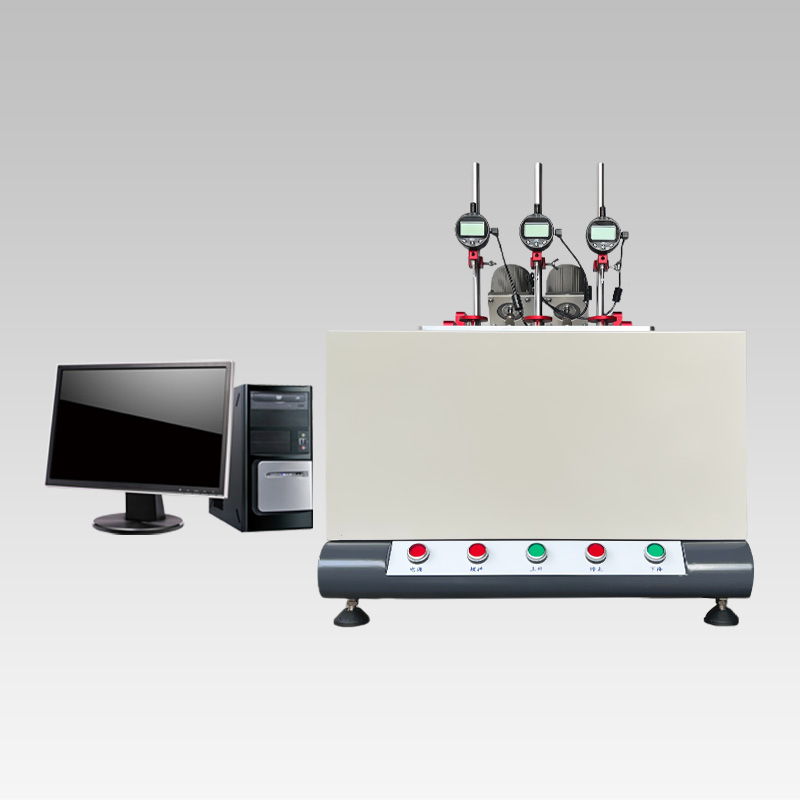


Function Introduction:
1. The thermal deformation temperature tester uses a single-chip microcomputer control system and a computer for display operation. It is mainly used for measuring the thermal deformation temperature and Vicat softening point temperature of non-metallic materials such as plastic, rubber, nylon, electrical insulation materials, etc. The product meets the requirements of IS075 (E), IS0306 (E), GB/T8802, GB/T1633, GB/T1634 and other standards. It is an essential instrument for self inspection by various quality inspection units, colleges and universities, and enterprises.
2. The thermal deformation temperature tester is easy to operate, convenient to use, stable in performance, and has high product accuracy. It can monitor the test temperature and deformation amount in real time during the test process; At the end of the experiment, the system automatically stops heating and can print and store the test report and test curve.
Working principle:
Plastic bending load thermal deformation temperature: When the temperature is uniformly increased, the temperature at which the upper surface of the thermoplastic sample is bent and deformed to the specified deflection under the standard specified load conditions is measured by the standard indenter.
Execution standards:
ISO75-1:1993 "Plastics - Determination of deformation temperature under load"
ISO306:1994 "Plastics - Determination of Vicat softening point temperature of thermoplastic materials"
GB/T1633-2000 "Determination of Vicat softening point temperature of thermoplastic materials"
GB/T1634-2004 "Plastics - Determination of load deformation temperature"
Main technical parameters:
Temperature control range: oil temperature~300 ℃
Temperature resolution: 0.1 ℃
Maximum temperature control error: ± 1 ℃/6 minutes (120 ℃/h),
± 0.5 ℃/6 minutes (50 ℃/h)
Heating rate: set arbitrarily between 120 ℃/h, 50 ℃/h, and 50 ℃/h to 120 ℃/h.
Maximum deformation measurement range: 0-12.7mm
Maximum deformation measurement error: ± 0.005mm
Hot deformation test span: 64mm, 100mm
Heat deformation head and support radius: R3 ± 0.02mm
Vicat needle area: 1mm2 Vicat needle length: 4mm
Number of sample racks: 3
Heating medium: Methylsilicone oil (below 200 millimeters, flash point above 300 ℃)
Maximum heating power: 3.4KW
Control power supply (main power supply): 220V ± 10%, 15A, 50Hz
Heating power supply (auxiliary power supply): 220V ± 10%, 5A, 50Hz
Weight mass: quantity of each sample holder, in grams
Weight Quality Weight Quantity Weight Grade Weight Quality Weight Quantity Weight Grade
1000 4 M1 20 2 M1
500 1 M1 10 1 M1
200 2 M1 5 1 M1
100 1 M1 2 2 2 M1
50 1 M1 1 1 M1
Calculation of test load:
The calculation formula for the load (weight mass) of the hot deformation temperature test is
F=2 σ Bh2/(3L) F: Required load force (N)
σ: Standard fiber stress, method A σ= 1800Kpa,
Method B σ= 450Kpa
b: Sample width(m) H: Sample height (m)
L: The distance between the two support points of the test stand, i.e. the test span (m)
The Vicat temperature test load (weight mass) is 9.81N (1kg weight) for method A and 49.05N (5kg weight) for method B.
